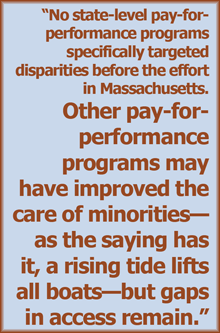Synopsis
In 2006, Massachusetts established a pay-for-performance program to reduce racial and ethnic disparities in hospital care for Medicaid patients. Using data from the first year of the program, the authors of this article found little evidence of disparities in care. This finding and others raise questions about the utility of addressing disparities in hospital care through pay-for-performance.
Background
As part of state health care reform passed in 2006, Massachusetts established a pay-for-performance initiative in its Medicaid program to financially reward hospitals that performed well on certain measures. As part of this program, the state took an unusual step: allotting a portion of the program’s incentive payments to reducing racial and ethnic disparities in health care. A Health Affairs article, coauthored by former Commonwealth Fund Harkness Fellow Tim Doran, M.D., examines the challenges of developing and launching such a program. In preparing the article, the authors reviewed public documents, analyzed hospital performance data, met with Medicaid staff, and interviewed hospital administrators and staff members at the Massachusetts Hospital Association.
Using Pay-for-Performance to Reduce Racial and Ethnic Disparities
 After consulting with members of the hospital community, major payers in the state, and various government committees, the Massachusetts Medicaid office decided to use clinical performance measures related to surgical infection protection, pneumonia, pediatric asthma, and maternity and newborn care in the pay-for-performance program. In addition, the office included structural measures related to cultural and linguistic standards, including interpretation and translation services and analyzing patient data by race, ethnicity, and languages spoken. For the first year of the program (October 2007–September 2008), $4.5 million was available in incentives. By the third year (October 2009–September 2010), incentive payments were scheduled to rise to $32 million.
After consulting with members of the hospital community, major payers in the state, and various government committees, the Massachusetts Medicaid office decided to use clinical performance measures related to surgical infection protection, pneumonia, pediatric asthma, and maternity and newborn care in the pay-for-performance program. In addition, the office included structural measures related to cultural and linguistic standards, including interpretation and translation services and analyzing patient data by race, ethnicity, and languages spoken. For the first year of the program (October 2007–September 2008), $4.5 million was available in incentives. By the third year (October 2009–September 2010), incentive payments were scheduled to rise to $32 million.
Using performance data from 64 hospitals in the first year of the program, the authors found little evidence of disparities in care. For the 55 hospitals with eligible patients of more than one race, the data showed uniform treatment of patients, regardless of race or ethnicity.
Hospital administrators were supportive of the program's goals of reducing racial and ethnic disparities and said the program had inspired discussions about disparities in their institutions. However, the authors found that many were also critical of the program. Some expressed frustration at having to adapt to yet another reporting system. Other questioned the validity of the structural measures. For instance, many hospitals had insufficient patient diversity to make the effort of analyzing patient data by race, ethnicity, and languages spoken worthwhile. (Massachusetts stopped using structural measures in the program in the summer of 2010.) The greatest dissatisfaction reported by hospital staff came from the program's focus on documentation at the expense of practical advice to help reduce disparities, described by one hospital quality improvement officer as a "compliance mind-set rather than improvement mind-set."
Lessons Learned
The program is still in its early stages, but certain lessons are clear.
- Recent evidence suggests that minority patients receive their care from a small subset of providers who may offer lower-quality care. Rather than focusing on inequities in quality within a hospital, a more effective way to reduce disparities may be to target hospitals serving greater numbers of minority patients.
- Without sufficient numbers of patients, program administrators cannot reliably identify high-performing providers or make fair decisions about distributing incentive payments.
- Not all disparities statistics are equal. For instance, the "between-group variance" measure chosen by the Massachusetts Medicaid office reflects uniformity of care. As a result, hospitals with few minority patients score well. "Penalizing diversity in this way would seem to be at odds with the goal of reducing disparities," the authors state.
- The Massachusetts Medicaid office took a regulatory approach, employing simple lists of performance measures, rather than the “back-and-forth” process used by the Joint Commission. Hospitals are more familiar with the Joint Commission’s approach, which assesses whether hospitals are meeting standards and then helps them develop a road map to follow. While this approach requires more resources, it may be a better catalyst for organizational change, the authors say.


